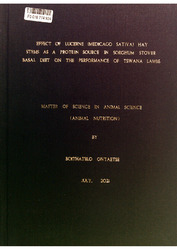Effects of lucerne (medicago sativa) hay stems as a protein source in sorghum stover basal diet on the performance of Tswana lambs
Abstract
The current study was designed to assess the performance, development of the reproductive and carcass parameters of Tswana lambs fed lucerne hay stems as a protein source in sorghum stover basal diet. This was achieved through feeding Tswana lambs lucerne hay stems as a protein source in sorghum stover diets with the expectation that the lamb’s performance would be positively affected. Forty-two (42) Tswana lambs (21 rams and 21 ewes), aged 7 months, with initial body weights of 20.54 ±1.12 and 19.28 ± 1.12 kg for rams and ewes respectively were randomly allocated to three (3) experimental diets with seven (7) replications. Experimental diets involved; Treatment 1 (sorghum stover + molasses urea block) as a control diet, Treatment 2 (sorghum stover mixed with lucerne hay stems at 200g), and treatment 3 (sorghum stover mixed with lucerne hay stems at 400g) were fed to the lambs. There was a treatment x sex interaction (P = 0.0001) for DM, CP, and NDF intakes by Tswana lambs. A treatment x sex interaction was also observed for apparent digestibility of DM (P = 0.002), CP (P = 0.0001) and ADF (P = 0.03). Lambs fed on T3 diet had a greater (P = 0.06) apparent digestibility of NDF than those fed on T1 diet. A treatment x sex interactions for ADF1 (P = 0.0001), BWG (P = 0.02) and ADG (P = 0.01) were observed in Tswana lambs. Ram lambs had the greatest FCR (P = 0.06) and FBW (P = 0.07) than ewe lambs. There were no (P>0.05) difference for reproductive parameters for rams lambs across all treatments except for sperm counts (P = 0.01) and normal sperm morphology (P = 0.05) for lambs fed T2 diet. Teat length was the largest (P = 0.02) for ewe lambs fed on T3 diet. Vagina length was longer (P = 0.06) for ewe lambs fed diet T3. Fallopian tube length was shorter (P = 0.01) for ewe lambs fed the Tl diet. Following the feeding trial, lambs were slaughtered to determine carcass parameters measured. There was a treatment x sex interaction for SW (P = 0.0003), EBW (0.004), full GIT weight (0.01), gut fill weight (0.01), empty GIT weight (0.05), HCW (0.01), CCW (0.01)vii and carcass grade (0.01) for Tswana lambs. Differences were noted for dressing percentage on SW (P = 0.07) and on EBW (P = 0.06), respectively with lamb fed on T3 diet recording the highest dressing percentage. Sex had an influence on total lean (P = 0.07), and total bone weights (P = 0.001) with rams lambs registering the best weights than ewe lambs. It was concluded that lucerne hay stems at 400g had a higher protein contribution that influenced growth, reproductive performance, and the carcass traits of Tswana lambs. Therefore, lucerne hay stems at a higher level can be included in sheep diets as a protein source to supplement highly fibrous feed.
Collections
- Theses and Dissertations [133]

